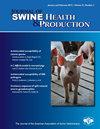在紧急情况下减少猪生长的营养策略
IF 0.7
4区 农林科学
Q3 Agricultural and Biological Sciences
引用次数: 0
摘要
多种喂养策略已被证明可在紧急情况下减少生长。饲喂低蛋白质饲粮可使平均日增重(ADG)降低71%,且胴体瘦度下降,这取决于限制程度。饲喂过量蛋氨酸可使平均日增重降低67%,但对胴体瘦度影响有限。饲粮中蛋氨酸含量超过2%可能导致体重下降。饲喂氯化钙或氯化铵可使平均日增重降低98%,这取决于所加的膳食电解质失衡,并可导致胴体更瘦,通过颜色、pH值和嫩度衡量的肉质可能更差。本文章由计算机程序翻译,如有差异,请以英文原文为准。
Nutritional strategies to reduce growth of pigs during emergency situations
Multiple feeding strategies have been shown to reduce growth in emergency situations. Feeding low protein diets decreased average daily gain (ADG) up to 71% depending on the degree of restriction and resulted in decreased carcass leanness. Feeding excess methionine decreased ADG up to 67%, with limited effects on carcass leanness. Feeding methionine in the diet above 2% may result in body weight loss. Feeding calcium chloride or ammonium chloride decreased ADG up to 98% depending on the dietary electrolyte imbalance imposed and can result in leaner carcasses and potentially poorer meat quality as measured by color, pH, and tenderness.
求助全文
通过发布文献求助,成功后即可免费获取论文全文。
去求助
来源期刊
CiteScore
1.80
自引率
0.00%
发文量
29
审稿时长
>36 weeks
期刊介绍:
The Journal of Swine Health & Production (JSHAP) is an open-access and peer-reviewed journal published by the American Association of Swine Veterinarians (AASV) since 1993. The aim of the journal is the timely publication of peer-reviewed papers with a scope that encompasses the many domains of applied swine health and production, including the diagnosis, treatment, management, prevention and eradication of swine diseases, welfare & behavior, nutrition, public health, epidemiology, food safety, biosecurity, pharmaceuticals, antimicrobial use and resistance, reproduction, growth, systems flow, economics, and facility design. The journal provides a platform for researchers, veterinary practitioners, academics, and students to share their work with an international audience. The journal publishes information that contains an applied and practical focus and presents scientific information that is accessible to the busy veterinary practitioner as well as to the research and academic community. Hence, manuscripts with an applied focus are considered for publication, and the journal publishes original research, brief communications, case reports/series, literature reviews, commentaries, diagnostic notes, production tools, and practice tips. All manuscripts submitted to the Journal of Swine Health & Production are peer-reviewed.

 求助内容:
求助内容: 应助结果提醒方式:
应助结果提醒方式:


